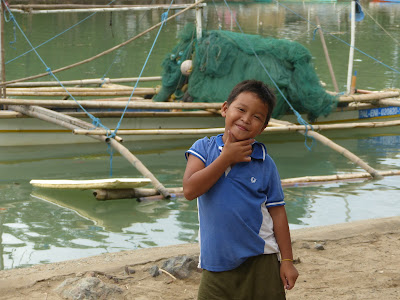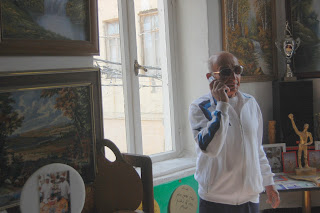Three Philippines Scenes
A trip downtown
We are staying with our gracious Filipino hosts in Santa
Rita, a suburb of Olongapo,
a city of about 240,000 situated on the coast, a two hour drive north-west of Manilla.
The street outside the family compound is buzzing. Mom and pop stores and street
restaurants are doing brisk business. By 11 a.m. pupils in school uniforms are
returning for their lunch break after starting at 6 a.m. A peddler yells “taho!”
- a popular breakfast drink made of silken tofu and tapioca pearls. There’s
plenty to see here but today we’re going downtown.
Getting to downtown Olongapo involves two trips using public transportation, first by a motorized tricycle or tuk tuk taxi and then
by a jeepney bus (originally
made from leftover American jeeps). Both vehicles are canvases for the Filipino
art form of kitsch decorations that add anarchic flashes of colour to the streets.
Many of them also carry the uplifting municipal
slogans – “Transparency and Good Governance”, “Aim High Olongapo” - to be found
on available spaces throughout the city.
In fact, my first impression is that Olongapo municipality is
expert at window dressing, not only via the ubiquitous inspirational slogans but also for
example by lining the badly lit streets with massive electric red hearts in
honour of Valentine Day. This, in a bid perhaps, to cover up the less attractive
sites of neglect and disrepair?
M. an Olongapo native now living in New York notes, while
scrunched into a jeepney, that while public transportation in the Philippines
is uncomfortable and polluting, it’s also cheap and readily available. If you
miss your train in New York, you’re looking at an expensive Uber ride home, she
says. Here you can pick up a tuk tuk in a jiffy for a few cents.
Passengers get on and off, money is passed along to the
driver Tel Aviv sherut style. An older man gets on and sits opposite
M. It’s her godfather, a respected teacher, and she places his hand on her brow as a sign of respect for her elders. Later a
young person does the same to me. Unused to such demonstrations of respect, I’m taken
aback.
The big public market has plenty of attractions, especially
in the food section but before long the heat, noise and pollution in the chaotic
streets are taking their toll and M. leads us across a river into a much quieter zone.
This is formally known as the Subic Bay Special Economic and
Freeport Zone and until 1992 was the site of a massive US naval base. No fuel-guzzling
jeepneys and noisy tuk tuks here and no shanty towns either. Instead, gleaming
white taxis and expensive SUVs glide along wide straight roads lined with malls,
cinemas and restaurants and the offices of international corporations. The
Freeport is now run by a special authority which “provides tax and duty free
privileges and incentives to business locators in the special economic zone.” There are guards at the entrances and the
entire area functions under its own traffic rules (First to stop at a junction,
first to go).
To my eyes, the contrast between messy, rundown, Olongapo and
its sanitized neighbour Freeport is blatant. A swanky “international” showcase on
one side of the river and its poor cousin on the other. But a bit of
digging reveals that the departure of the Americans that allowed the Freeport
to be established was actually instrumental in turning around Olongapo’s fortunes. In the 1960s when its
bars and brothels served thousands of US servicemen, Olongapo was considered “sin city”. Yet today
it is considered a national “model”, known for its “innovative methods of urban
management” and is the recipient of numerous awards.
So much for first impressions.
An indigenous meal
A short drive from Olongapo city, leads us into a lush tropical
forest. We stop at a spot called Pamulaklakin, the home of an indigenous family
group belonging to the Aeta people, themselves belonging to the wider Negrito
group, one of the Philippine’s many ethnic minorities and sometimes referred to
as the aborigines of the Philippines. Our hosts have developed a close relationship
with them and have arranged a cook out. We bring the food, they cook – indigenous
forest-dwellers style.
We traipse down a
path accompanied by two friendly indigenous ladies with fearsome machetes tied
to their waists, cross a bridge and set up camp alongside a stream in a shady
area with a few tables and benches.
The ladies disappear into the forest. Chopping sounds. The ladies
reappear clutching long poles of bamboo which they now expertly lop into
cooking sized cylinders. Short and very accurate cuts create a replaceable
window for cooking rice. Another few cuts produce bamboo tongs for handling the
food. We are amazed by their expertise. A
fire has been lit and the bamboo ‘pots’ have been filled with mussels, pork,
rice, fish and vegetables. They simmer on the fire while we paddle in the sun-dappled
stream, dazzled by the butterflies and water insects.
Soon, the food is poured out of the bamboo cooking pots, we share a delicious meal and offer our compliments to the proud chefs. The organic leftovers are gathered in banana leaves and buried.
Soon, the food is poured out of the bamboo cooking pots, we share a delicious meal and offer our compliments to the proud chefs. The organic leftovers are gathered in banana leaves and buried.
I hear later that there is a community of displaced indigenous
people living in Olongapo City where they live in poor conditions, among other
things, because of their limited skills. We westerners wouldn’t last a
week in their forest while the ostensibly “primitive” Aeta ladies who efficiently
cooked a meal for 12 people using only a machete, could only feel redundant in a modern shopping mall. This is one country with different groups of people living in vastly different stages of development.
Bucana beach
We are in Bucana, a fishing village perched along the mouth of a river in the El NIdo District of Palawan Island. We have already spent a few days exploring this beautiful coastline with its archipelago of unpopulated islands rising dramatically from the sea. Island hopping for tourists is a mainstay of the local economy and we hear that obtaining a license to operate a tour boat can take years. As everywhere else, it helps to know the right people.
Now on our last stop in Palawan, the idea is to just chill
and read in an isolated spot with no commercial distractions. Bucana certainly fits
the bill. The river cuts the village in two and crossing it to get to the beach
involves us carrying our luggage over a hanging bridge made of planks and
twisted wire.
Safe and sound at Zhaya’s Beach and Cottages (recommended), one of only
three simple camps on the long, unspoiled beach, we can unwind in the shade of the
coconut palms and observe life at our leisure. The beach is a thoroughfare for the people
living along it and for us observers provides a clean, backdrop that focuses the
eye on whoever happens to be crossing it at the time: a family of four on one motorbike;
a gaggle of children chasing a dog wearing a dress; a lady carrying a parasol or a
water buffalo dragging a sled laden with bags of rice and a little boy.
We wander along the ramshackle lanes of the village between
the tin and palm frond dwellings and simple shops all selling the same snacks
and drinks, say hello to the friendly barefoot children who ask “What’s your name?” in
English. I take photos and the kids are happy to pose but at some point I feel uncomfortable
wandering around this “authentic” but abjectly poor village with my fancy digital
camera like some western colonialist documenting the “natives”.
Not that the people of Bucana seem unhappy. The children in
particular, here and in other rural areas we visited, are often seen in little
giggling gangs, deeply engrossed in games involving little more than a wheel on
a stick. Even without understanding Tagalog you could see that they were
actually using their imagination to play. Sometimes, less can be more.
As I watch the fishermen putting out to sea in their simple bangka
boats in a scene that might not have changed for centuries, I pan to a
woman peering into a smartphone outside a family shop and then start spotting the
TV antennas on the rooftops. Bucana is not disconnected from the outside world.
It sits on the border between the traditional and the new and seems to accept
both with equanimity.
Everywhere we went in the Philippines we met warm and friendly
people and were often struck by their humility and modesty. Life is hard for so many of them yet they seem
to face it with a fatalism and a carefree attitude, alongside a deep attachment
to family and friends, that we spoiled westerners could find instructive.
Grateful thanks goes to the De Jesus Lumibao family for
their generous hospitality.
















Comments